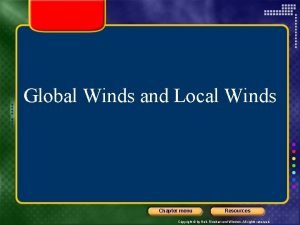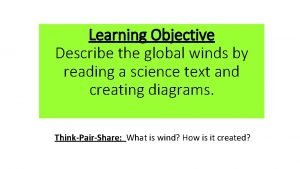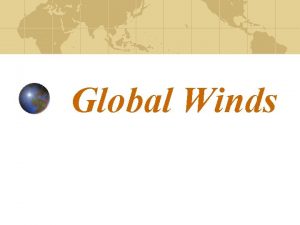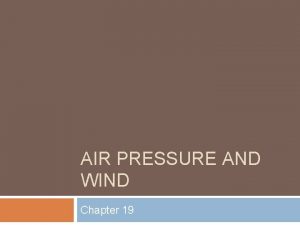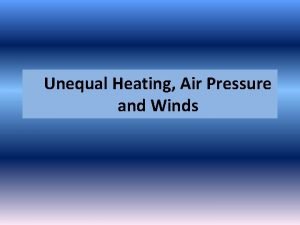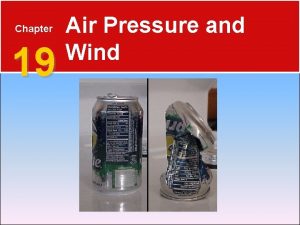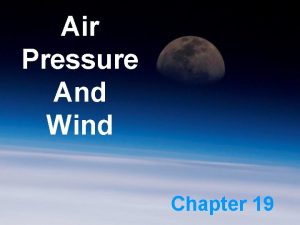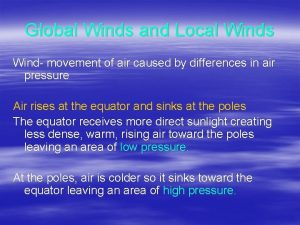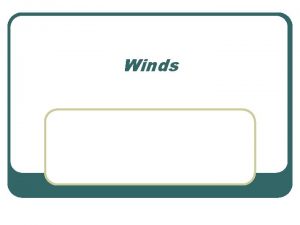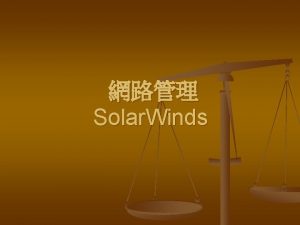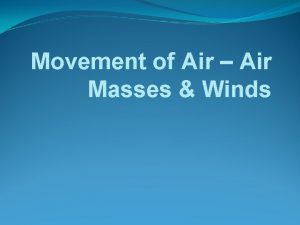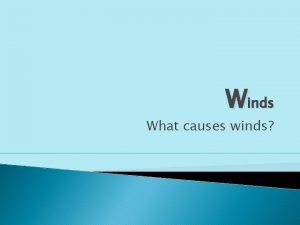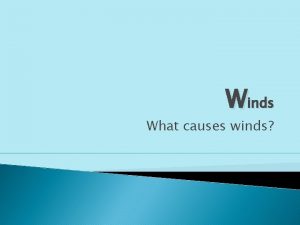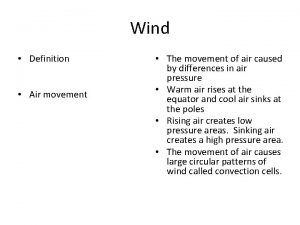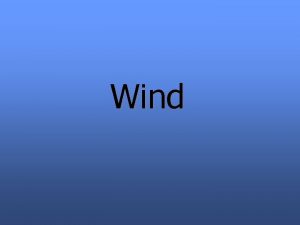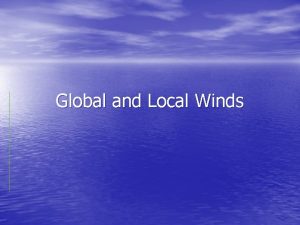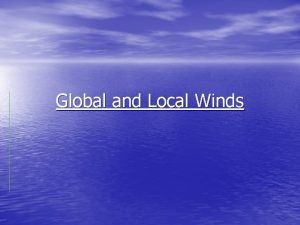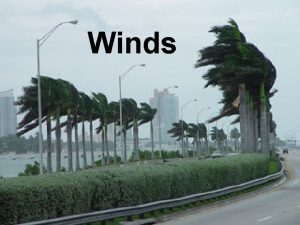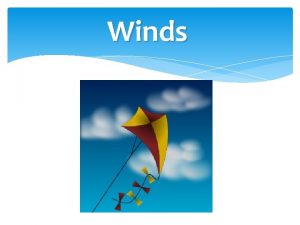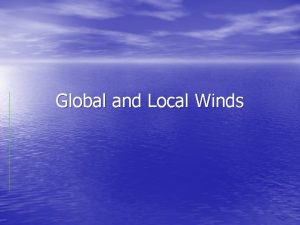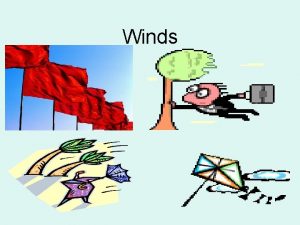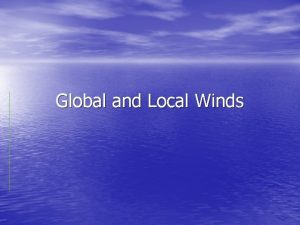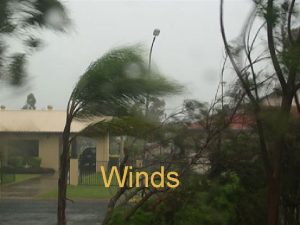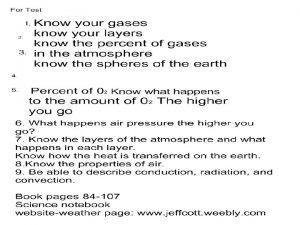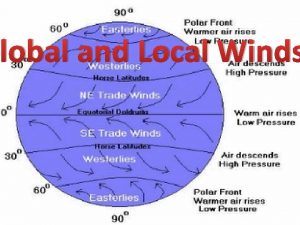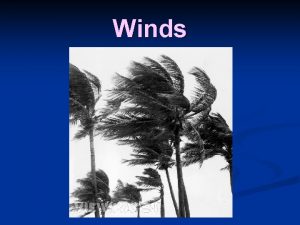Winds The Movement of Air Wind Air in

























- Slides: 25

Winds The Movement of Air

Wind § “Air in motion. ” – The main factor that causes winds is uneven heating of the earth’s surface! § Convection currents drive all wind patterns. – Masses of air travel from one place to another because of temperature and pressure gradients. § Differences in air pressure are caused by differences in temperature.

Properties of Air Masses § As air touching the ground heats up, it expands and becomes less dense. – Less dense air rises. – Warm air can hold more moisture. § Air aloft cools down, and condenses or shrinks, becoming more dense. – More dense air sinks. – Cool air can hold less moisture.

Convection Currents § Driven by differences in density. § As air moves from one place to another, more air rushes in to replace it from the side. – This sets up a continuous cycle of moving air called a convection cell. § Air moving from the side is called “wind”.

Pressure Gradients § Differences in pressure that push or pull air masses from places with more air (high pressure) to places with less air (low pressure). – Wind always moves from areas of high pressure to areas of low pressure. – The greater the difference in pressure, the stronger the wind.

Naming Winds § Winds are named according to the place the come from. – A north wind (northerly) comes from the north, a westerly from the west, and so on. § There are very few exceptions to this rule.

Local & Seasonal Winds on a Relatively Small Scale

Sea Breeze § Wind that moves from the sea to the land. § Carries cool, moist air and frequently causes rain. § Driven by convection cells. – Land heats faster than water, so the land has low pressure while the sea has high pressure. § Air rises over the land sinks over the sea. § Air moves in sideways to fill in the low pressure area over the land. – Happens at beaches and lakes during the day.

Land Breeze § Wind that moves from the land to the sea. § Carries warm, dry air and frequently causes clear weather. § Driven by convection cells. – Land cools faster than water, so the land has high pressure while the sea has low pressure. § Air sinks over the land rises over the sea. § Air moves in sideways to fill in the low pressure area over the sea. – Happens at beaches and lakes during the night.

Monsoon § Seasonal winds that affect the tropical regions of western Asia. – A special case of a land/sea breeze pattern that lasts for an entire season. § The warm western Pacific Ocean causes a land breeze all winter long, creating a “dry season”. § The tropical land heats up more during the summer, causing a “rainy season”.

Mountain Breeze § Wind that moves down from a mountain to the valley below. – Also called a “katabatic wind”, or a downslope wind. § Carries cold, moist air and frequently causes fogs and severe frosts. § Driven by convection cells. – The tops of mountains cool faster than the valleys below, so the mountain has high pressure while the valley has low pressure. § Air sinks over the mountain, falling into the valley. – Happens at mountains during the night.

Valley Breeze § Wind that moves up from a valley to a mountain. – Also called an “anabatic wind”, or an upslope wind. § Driven by convection cells. – The tops of mountains heat up faster than the valleys below in the morning, so the mountain has low pressure while the valley below has high pressure. § Air rises over the mountain, then circulates and falls back into the valley. – Happens at mountains during the day.

Global Winds Air Circulation Around the World


Uneven Heating § The poles receive little direct sunlight, and are always cool. – The cold air over the poles is constantly sinking. § A permanent high pressure system sits over both poles, bringing clear, dry weather. § The equator receives lots of direct sunlight, and is always warm. – The hot air over the equator is constantly rising. § A permanent low pressure system sits over the equator, bringing rainy weather.

Permanent Pressure Systems § Permanent low pressure at 0° (equator). § Permanent high pressure at 30° north and south (horse latitudes). § Permanent low pressure at 60° north and south. § Permanent high pressure at 90° north and south (poles). – The differences in pressure between these zones drives global winds!

Coriolis Effect § The deflection of free moving objects to one side or the other due to the earth’s rotation. – Winds and currents are curved to the right north of the equator. – Winds and currents are curved to the left south of the equator. § The Coriolis Effect breaks the global circulation pattern into three distinct bands from the equator to the poles, and generates the pressure bands at 30° and 60°. – Without the earth’s rotation, global winds would only travel in one direction!

Major Surface Wind Patterns § § § Trade Winds Prevailing Westerlies Polar Easterlies Doldrums Horse Latitudes


Trade Winds § Found between 0° and 30° north and south. – Blow from the northeast in the northern hemisphere, and from the southeast in the southern hemisphere (towards the equator and from the east). § Named because they aided trading ships in the great sailing days.

Prevailing Westerlies § Found between 30° and 60° north and south. – Blow from the southwest in the northern hemisphere, and from the northwest in the southern hemisphere (towards the poles and from the west). § Provided reliable route from Americas to Europe.

Polar Easterlies § Found between 60° and 90° north and south. – Blow from the northeast in the northern hemisphere, and from the southeast in the southern hemisphere (from the poles and east). § Exact same direction as the Trade Winds, opposite of the Prevailing Westerlies.

Doldrums § Windless area around the equator. – Permanent low pressure area means air rises instead of moving to the side. § Air rises swiftly from the surface: air masses go up before they get there, leaving a belt with no surface winds. – Rising, moist air causes a band of rain along the doldrums much of the time. – Sailors would get stuck there for days because of the lack of wind.

Horse Latitudes § Windless area around 30° north and south. – Permanent high pressure area means air sinks instead of moving to the side. § Air sinks swiftly: air masses go down immediately surrounding the area, leaving a belt with no surface winds. – Sinking, dry air causes a band of deserts to exist along the Horse Latitudes around the globe. – Named because sailors would get stuck there and would often have to dump their cargo to lighten the load. . .

Video Bibliography § Investigating Weather. United Learning (1995). Retrieved January 27, 2006, from unitedstreaming: http: //www. unitedstreaming. com/ § Weather Smart: Heat, Wind, and Pressure. United Learning (2001). Retrieved January 27, 2006, from unitedstreaming: http: //www. unitedstreaming. com/ § Science Investigations Earth Science: Investigating Weather and Climate. Discovery Channel School (2004). Retrieved January 27, 2006, from unitedstreaming: http: //www. unitedstreaming. com/ § Physical Science: Heat. Discovery Channel School (2002). Retrieved January 27, 2006, from unitedstreaming: http: //www. unitedstreaming. com/ § Exploring Weather: The Atmosphere in Motion. United Learning (1993). Retrieved January 27, 2006, from unitedstreaming: http: //www. unitedstreaming. com/
 Local winds and global winds
Local winds and global winds Prevailing westerlies
Prevailing westerlies Trade winds blow from the
Trade winds blow from the What is the difference between global and local winds?
What is the difference between global and local winds? Local and global winds
Local and global winds What is the horizontal movement of air called
What is the horizontal movement of air called Raumschotkurs
Raumschotkurs Hubungan air tanah dan tanaman
Hubungan air tanah dan tanaman Light gun signals
Light gun signals Which of the following is an example of axial movement
Which of the following is an example of axial movement Chapter 19 air pressure and wind answer key
Chapter 19 air pressure and wind answer key Study jams air pressure and wind
Study jams air pressure and wind Sea breeze usually originates during the
Sea breeze usually originates during the Chapter 19 air pressure and wind
Chapter 19 air pressure and wind Các châu lục và đại dương trên thế giới
Các châu lục và đại dương trên thế giới Bổ thể
Bổ thể Từ ngữ thể hiện lòng nhân hậu
Từ ngữ thể hiện lòng nhân hậu Diễn thế sinh thái là
Diễn thế sinh thái là Tư thế ngồi viết
Tư thế ngồi viết V. c c
V. c c Thể thơ truyền thống
Thể thơ truyền thống Phép trừ bù
Phép trừ bù Bài hát chúa yêu trần thế alleluia
Bài hát chúa yêu trần thế alleluia Hổ đẻ mỗi lứa mấy con
Hổ đẻ mỗi lứa mấy con đại từ thay thế
đại từ thay thế Vẽ hình chiếu vuông góc của vật thể sau
Vẽ hình chiếu vuông góc của vật thể sau
